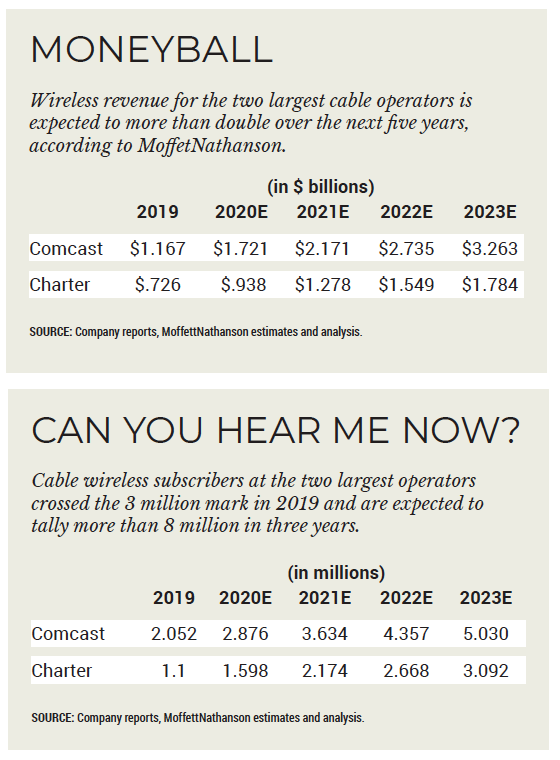Wireless Ventures Create Real Revenue for Cable
After several failed tries at the wireless business in the past few decades, cable operators appear to have found the right formula, adding customers at a record clip and evolving the offerings from a retention tool to one that could start turning a profit.

Two years after launching Xfinity Mobile, Comcast has about 2 million wireless customers, generating $1.2 billion in annual revenue. Charter Communications, which launched wireless product Spectrum Mobile in July 2018, crossed the 1 million subscriber milestone in 2019.
Neither offering is expected to be a threat to the Big Three wireless carriers, Verizon Communications, AT&T or T-Mobile/Sprint, which each have well more than 100 million mobile customers. But for cable, a business that was once believed to be an afterthought is now being considered alongside broadband as a possible profit center.
No Drag Anymore
“Wireless, within the next few years, will be a contributor rather than a drag,” MoffettNathanson principal and senior analyst Craig Moffett wrote.
Cable’s forays into wireless are legendary. The first joint venture between cable and wireless can be traced back to the Sprint PCS partnership in the 1990s, in which the cable partners cashed out at a considerable profit. But the next two attempts to create a quad play — the Pivot joint venture with Sprint and a wireless broadband JV with WiMax pioneer Clearwire — failed miserably.
Cable operators, mainly Comcast and Time Warner Cable (now part of Charter), continued to accumulate wireless spectrum in various federal auctions, selling those licenses to Verizon Communications in 2015 for $3.6 billion. As part of that deal, the cable operators retained the right to form a mobile virtual network operator (MVNO) agreement with Verizon, that would allow them to offer wireless service in their respective footprints.
Multichannel Newsletter
The smarter way to stay on top of the multichannel video marketplace. Sign up below.
Comcast was the first to launch its MVNO, Xfinity Mobile, in April 2017. Charter’s Spectrum Mobile followed about 18 months later. Both companies saw the services as mainly retention tools for their broadband and video offerings, not as standalone services or as cogs in a larger quad-play wheel of video, voice, data and wireless. Now that attitude seems to be changing.

In 2019, Comcast grew mobile revenue by 31.2% to $1.167 billion, ending the year with just over 2 million customers, compared to 1.2 million in the prior year. On its conference call with analysts to discuss Q4 results, Comcast chief financial officer Mike Cavanagh, who, like the overall company, had been cautious about wireless predictions in the past, seemed more than optimistic about the service, adding that he expected the wireless subscriber momentum to continue into 2020.
“Our results to date indicate that adding mobile improves broadband customer retention and increases prospective customers’ consideration,” Cavanagh said on the call. “And importantly, we continue to see a significant improvement in the financial performance at Xfinity Mobile. We reduced our quarterly adjusted EBITDA losses at Xfinity Mobile to $116 million, a 40% improvement compared to last year’s fourth quarter, and we expect Xfinity Mobile to be EBITDA positive for the full year in 2021.”
Charter, which launched Spectrum Mobile about a year after Comcast, did even better. It added 288,000 wireless subscribers in Q4, ahead of bullish consensus estimates of 260,000 additions. Management appears to be taking a more aggressive stance concerning mobile, with predictions of meaningful profitability by 2021.
On a conference call with analysts, Charter chief financial officer Christopher Winfrey said the company expects mobile service revenue to “exceed all operating costs” in 2021, adding that by that time, mobile capex should “decline meaningfully.”
Charter Changes the Narrative
Sanford Bernstein media analyst Peter Supino wrote that the wireless performance, coupled with stronger-than-expected results in just about every metric — revenue was up 5% and cash flow rose 8% in the quarter — have helped change Wall Street’s perception of Charter and its $80 billion purchase of Time Warner Cable in 2015.
“Thirteen months ago, we perceived that the market assessed the Time Warner Cable merger as a failure and heard rumors of risk to Charter CEO Tom Rutledge’s job,” Supino wrote. “Today, 81% higher on the stock, that consensus is a skeleton in some closets, and investors are happily adding risk while scrutinizing Charter’s outlook in search of the next thing that ‘we know for sure that just ain’t so.’ To be clear, we still see more to hope for than to fear.”
